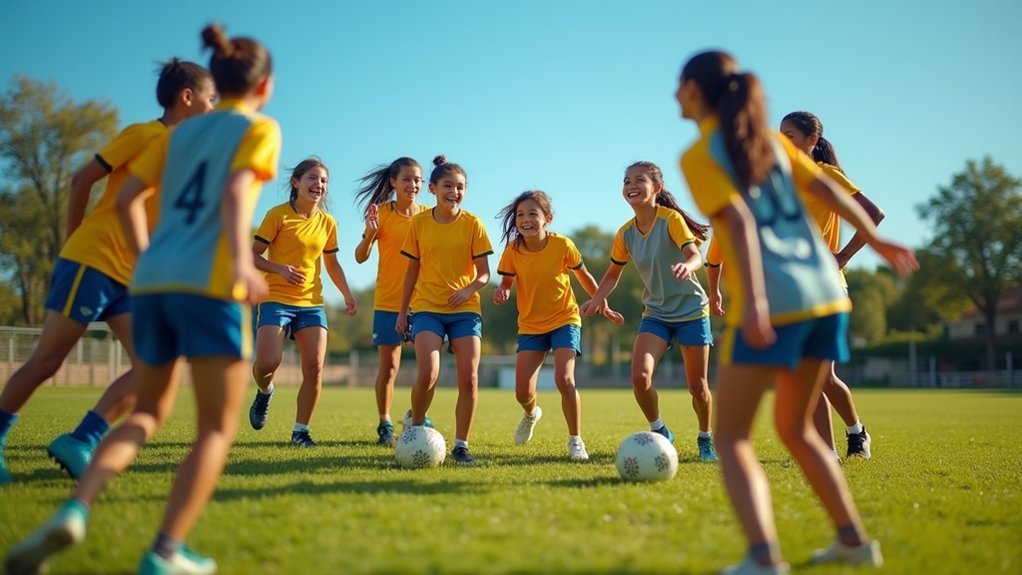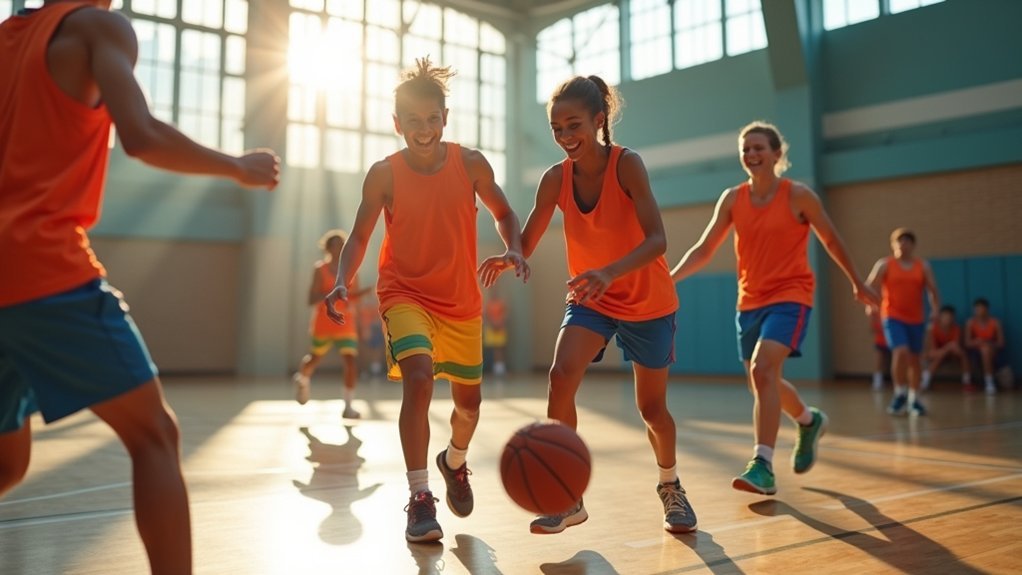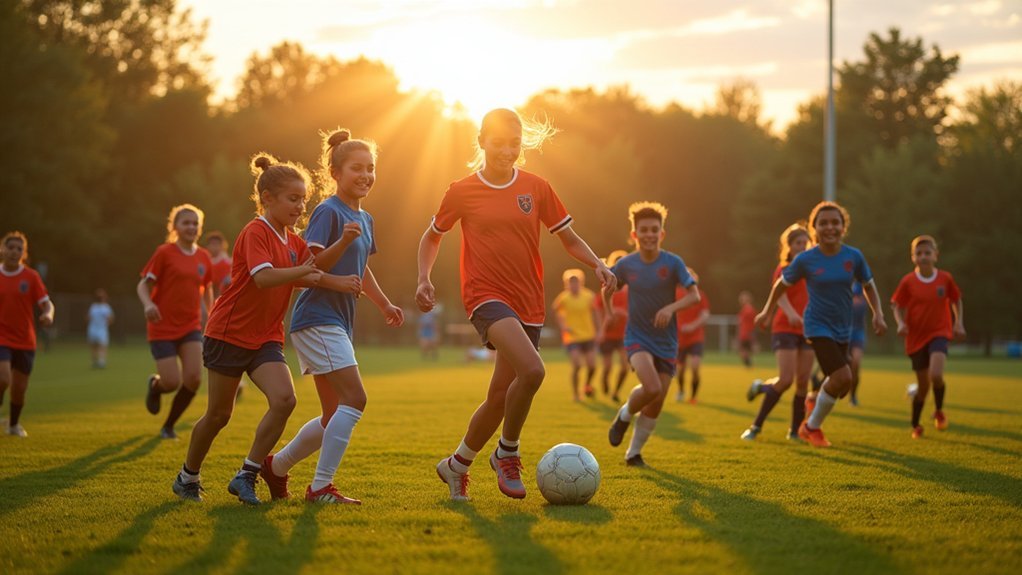Team sports offer powerful anxiety relief while fostering meaningful connections. Activities like rowing, modified basketball, and inclusive volleyball reduce anxiety symptoms by up to 50% through a combination of endorphin release, mindfulness, and social support. Low-impact options like team yoga provide alternatives for all abilities. You’ll benefit from decreased cortisol levels, improved communication skills, and a strong sense of belonging that transforms identity from “anxious” to “valued teammate.” The right sport awaits to change your mental health journey.
Team Sports That Calm Anxiety While Building Connection

While many people turn to individual activities for stress relief, team sports offer unique mental health benefits that extend beyond physical fitness. Research shows that participating in team sports can reduce your likelihood of depression by 50%, creating a supportive environment that naturally calms anxiety.
Team sports don’t just strengthen your body—they fortify your mind and nurture your social wellbeing.
When you join a team sport, you’re not just getting exercise—you’re building resilience and finding purpose through shared goals. This structure helps you develop essential social skills that decrease social anxiety and enhance your ability to form positive relationships.
The communication and cooperation required in team sports help you feel more connected and less isolated.
Youth who participate in team sports consistently show lower rates of anxiety and depression diagnoses compared to their non-participating peers, demonstrating these activities’ powerful protective effects.
The Science Behind Sports and Anxiety Reduction
When you participate in team sports, your brain releases mood-boosting endorphins and stress-reducing cortisol, creating a natural anti-anxiety effect.
The social connections you form with teammates trigger oxytocin production, which strengthens emotional bonds and builds resilience against anxiety.
Team sports also offer a powerful combination of mental distraction from worries and mindfulness through focused attention on the present moment.
Neurochemistry of Exercise
Although many people experience the mood-boosting effects of exercise firsthand, the science behind this phenomenon reveals fascinating neurochemical processes. When you participate in team sports, your brain releases endorphins and serotonin that effectively combat anxiety and other mental health issues.
The neurochemistry of exercise extends beyond these feel-good transmitters. Your body also produces brain-derived neurotrophic factor (BDNF), which supports neuron growth and enhances your overall sense of well-being.
Simultaneously, exercise reduces cortisol levels, creating a natural calming effect.
Team sports offer additional benefits through social interaction, triggering the release of oxytocin—the bonding hormone. This chemical reinforces feelings of connection with teammates while further reducing anxiety.
The more frequently you engage in these activities, the more pronounced these neurochemical benefits become.
Social Bonding Effects
Beyond the individual neurochemical benefits of exercise, team sports create powerful social bonds that greatly impact mental health outcomes. When you join a team, you’re entering a support system that can reduce depression risk by 50% through the meaningful connections you’ll form.
Unlike the shallow interactions often found on social media, team sports foster genuine relationships that build resilience against anxiety, especially for adolescents who’ve faced adverse experiences.
The structured environment provides:
- Enhanced communication skills development
- Improved emotional regulation capacity
- Trust-building opportunities with peers
- Consistent emotional support systems
Research consistently shows that teens participating in team-based activities report better mental health than those in other extracurricular pursuits, highlighting the unique anxiety-reducing power of collaborative physical activity.
Distraction and Mindfulness
These social connections work alongside powerful psychological mechanisms that explain why team sports specifically target anxiety. When you’re fully engaged in a game, the rhythmic, repetitive actions create a natural distraction from anxious thoughts, pulling your mind into the present moment.
Research shows regular team sports participation can reduce anxiety symptoms by up to 30%. This happens because you’re forced to focus on immediate tasks—passing the ball, positioning yourself, communicating with teammates—rather than dwelling on worries.
The mindfulness inherent in sports is particularly powerful. You learn to concentrate on your performance and team interactions, developing emotional regulation skills that transfer beyond the field.
Many teams even incorporate targeted mindfulness practices like breathwork and visualization, equipping you with practical tools to manage anxiety during both competition and daily life.
Rowing: Finding Rhythm and Unity on the Water
You’ll find healing for your mind as you glide through natural waterways, with research showing rowing can reduce depression and anxiety symptoms by up to 50%.
The synchronized movements you perform create a meditative rhythm that anchors you to the present moment, effectively quieting anxious thoughts.
When you row in unison with teammates, you’re not just building physical strength but also forming connections that considerably boost your mental resilience and emotional well-being.
Nature Heals Minds
While many team sports take place in artificial environments, rowing immerses athletes in the natural world with profound mental health benefits.
You’ll experience up to 50% reduction in depression and anxiety symptoms while developing essential mental resilience as you glide across the water.
The therapeutic aspects of rowing for youth athletes include:
- Meditative rhythm that grounds you in the present moment
- Natural beauty that offers peace and perspective
- Team bonds that cut depression risk by half
- Sense of purpose that decreases depression symptoms by 30%
The combination of rhythmic movement and natural surroundings creates a unique mental sanctuary.
As you row, you’re not just strengthening your body—you’re building a healthier mind through direct connection with nature and teammates.
Synchronized Movement Matters
Nature’s healing power in rowing amplifies through the sport’s defining characteristic: synchronized movement.
When you row, you engage in a collective rhythm that reduces anxiety through shared focus and coordination. This synchronized movement isn’t just physically demanding—it’s mentally grounding.
As your oar cuts through water in perfect harmony with teammates, you’re practicing mindfulness in motion. You’re anchored to the present moment, making it difficult for anxious thoughts to intrude. The rhythmic, unified action builds trust and communication skills essential for mental well-being.
Your rowing team often becomes a second family, creating relationships that can cut depression risk by half.
The combination of synchronized movement, natural environments, and strong social bonds makes rowing uniquely effective at calming your mind while connecting you to others.
Modified Basketball: Low-Pressure Teamwork Options

Traditional basketball can overwhelm those struggling with anxiety, but modified versions offer an excellent alternative for building social connections without the intense pressure. For young athletes, these adaptations create supportive environments where they can develop skills at their own pace.
These modifications typically include:
- Smaller team sizes (3-on-3 instead of 5-on-5)
- Shorter game periods to reduce fatigue and maintain focus
- Lower-pressure scoring systems that emphasize participation
- Simplified rules that build confidence through achievable goals
You’ll find that modified basketball shifts focus from competition to enjoyment and personal growth. This approach helps reduce performance anxiety while still fostering essential teamwork skills.
The emphasis on supportive interaction creates natural opportunities for social development—exactly what’s needed when building meaningful connections through sport.
Inclusive Volleyball Adaptations for All Abilities
Unlike rigid competitive formats, inclusive volleyball adaptations create welcoming spaces where people of all abilities can experience the joy of teamwork and physical activity. You’ll find options like seated volleyball or beach wheelchair volleyball that foster belonging while building social skills.
| Adaptation | Benefits |
|---|---|
| Lighter balls & lower nets | Accommodates varying physical abilities |
| Visual aids & simplified rules | Supports players with cognitive challenges |
| Smaller teams | Increases participation and engagement |
These modifications don’t just make volleyball accessible—they transform it into a powerful tool for reducing anxiety. As you participate, you’ll develop communication skills and form meaningful friendships. Research confirms that inclusive volleyball adaptations greatly improve self-esteem and emotional well-being, making this sport an excellent choice for anyone seeking connection while managing anxiety.
Mindful Soccer: Focusing on Process Over Outcomes

You’ll find that coordinating your breath with your movements on the soccer field creates a natural rhythm that calms the nervous system while maintaining competitive performance.
Implementing team mindfulness exercises before practices and games builds collective focus and emotional regulation skills that extend beyond sports into daily life.
When your entire team practices present-moment awareness together, you’re creating a supportive environment where connections deepen and performance anxiety naturally diminishes.
Breathing With Movement
Soccer players on mindful teams experience a powerful transformation when they integrate breathing techniques with their movements on the field.
By synchronizing your breath with each pass, sprint, or defensive stance, you’ll remain anchored in the present moment rather than worrying about the scoreboard.
Research shows breathing with movement can reduce anxiety symptoms by 30%, while simultaneously building non-verbal team communication.
You’ll develop these essential skills through practice:
- Deep inhalation while receiving the ball
- Steady exhalation when passing or shooting
- Rhythmic breathing during continuous movement
- Collective team breathing during high-pressure situations
This mindful approach creates a supportive environment where you’ll learn to manage emotions effectively.
Instead of fixating on winning, you’ll focus on the process, developing resilience and coping strategies that extend well beyond the soccer field.
Team Mindfulness Practice
The freedom found in process-focused play transforms the soccer field into a sanctuary for anxious minds. When you introduce mindfulness to team sports, you’re creating a solid foundation for young people to manage anxiety while building meaningful connections.
| Mindful Soccer Benefits | Impact on Anxiety |
|---|---|
| Focus on process vs. outcomes | Reduces performance pressure |
| Breath awareness techniques | Enhances on-field concentration |
| Non-verbal communication | Deepens team connection |
| Personal growth emphasis | Builds lasting self-confidence |
| Physical activity with purpose | Releases tension naturally |
Instead of fixating on winning, you’ll notice players developing stronger peer relationships through mindful soccer. They’ll communicate more effectively without words, strengthening their social skills. The visualization and breathing techniques they learn during physical activity become tools they’ll carry beyond the field—creating resilience that serves them in all life’s challenges.
Adaptive Swimming Relays for Confidence Building
While many team sports build camaraderie, adaptive swimming relays offer unique benefits by creating an inclusive environment where participants of all abilities can thrive together.
You’ll find these relays particularly effective at reducing anxiety while fostering meaningful connections.
When you participate in adaptive swimming relays, you’ll experience:
- Enhanced confidence as you contribute to shared team goals
- Reduced stress and anxiety through the combination of water therapy and social support
- Improved communication skills that transfer to daily interactions
- Personal growth through a structure that celebrates individual progress
The team dynamic creates a supportive atmosphere where you’re challenged without feeling overwhelmed.
As you develop swimming skills alongside peers, you’ll build both physical abilities and social connections that help combat anxiety long after leaving the pool.
Low-Impact Team Yoga and Movement Classes
Unlike traditional competitive sports, low-impact team yoga and movement classes create a sanctuary where connection flourishes without physical strain.
These calming group activities help build your mind-body awareness while greatly reducing anxiety and stress levels.
Finding stillness together creates profound calm, allowing us to reconnect with ourselves while dissolving the tension of daily life.
You’ll discover the unique benefits of practicing in a supportive environment where friendships naturally develop and social skills strengthen.
The gentle movements and breathing techniques improve your focus and emotional regulation, making it easier to manage anxiety during group interactions.
Regular participation not only boosts your self-esteem and confidence but also enhances your physical wellness through improved balance and flexibility.
For those who struggle with social anxiety, these classes offer a non-threatening entry point to group activities where you can connect with others while honoring your personal comfort level.
Unified Track and Field: Individual Efforts, Team Spirit
For those seeking a balanced approach to athletic participation, Unified Track and Field offers a remarkable blend of personal achievement and team camaraderie. This inclusive sport brings together athletes with and without intellectual disabilities, allowing you to focus on your individual efforts while still enjoying the benefits of team connection.
Research confirms that participating in Unified Track and Field can greatly improve your mental health by:
- Reducing anxiety through supportive, low-pressure competition
- Building self-esteem as you set and achieve personal bests
- Developing meaningful friendships through shared experiences
- Creating a sense of belonging through mutual encouragement
You’ll experience the unique satisfaction of improving your personal performance while simultaneously contributing to a team atmosphere where everyone celebrates each other’s successes.
Creating Safe Spaces: Coaching Strategies for Anxious Athletes
Although athletic performance often focuses on physical skills, effective coaches recognize that creating psychologically safe environments is equally crucial for anxious athletes. The best coaching strategies begin with normalizing pre-competition nerves, reassuring athletes that these feelings are common and manageable.
You’ll find that implementing structured routines before competitions reduces anxiety by creating familiarity and comfort. Encourage open communication where team members can express concerns without judgment, building essential trust between you and your athletes.
Introduce mindfulness techniques like deep breathing exercises to help athletes center themselves and focus on performance rather than anxiety.
Finally, invest time in team-building activities that strengthen relationships among teammates. When athletes feel they belong to a supportive community, their isolation diminishes and their confidence grows—transforming anxiety into motivation.
Success Stories: How Team Sports Transformed Anxiety Sufferers
Behind every statistic lies a human story of transformation. When you hear that team sports reduce anxiety by 30%, you’re actually witnessing life-changing journeys of young athletes who found their voice on the field after years of silence.
Consider what these transformations often include:
- Building meaningful friendships that extend beyond practice hours
- Developing practical coping strategies that work in high-pressure situations
- Finding a sense of belonging that counters isolation
- Creating positive identity shifts from “anxious kid” to “valued teammate”
These aren’t isolated cases—they represent the 50% of individuals with difficult childhoods who discovered healing through teamwork.
The supportive dynamics of team environments provide exactly what anxiety sufferers need most: connection, purpose, and the powerful reminder that they’re not facing challenges alone.
Frequently Asked Questions
What Sports Are Good for Socially Anxious People?
You’ll thrive in individual sports like tennis or martial arts, track and field for personal competition, yoga for mindfulness, or rowing for wordless teamwork. Supportive team environments can also build your social skills gradually.
What Are the Best Team Sports for Mental Health?
Basketball, soccer, and volleyball are your best options for mental health. They’ll reduce your depression risk by 50%, build your emotional resilience, and create a sense of belonging through regular teamwork and communication.
What Sports Build Self Confidence?
You’ll boost your confidence through track and field, yoga, tennis, martial arts, and team sports. They each develop self-esteem through personal achievements, mind-body connection, skill mastery, discipline, and collaborative success.
How Do Athletes Calm Anxiety?
You’ll calm anxiety through deep breathing techniques, positive self-talk, and reframing nervousness as excitement. Practice mindfulness and visualization regularly. Physical activity itself reduces anxiety symptoms by 30%, while strengthening your mental resilience.
In Summary
You’ve discovered powerful ways team sports can transform your relationship with anxiety. Whether you’re gliding across water, shooting hoops, or finding your balance in yoga, these activities offer more than exercise—they provide community and belonging. When you join forces with teammates who understand your struggles, you’ll build resilience together. Don’t wait to experience the calming, connecting power of team sports in your journey toward wellbeing.





Leave a Reply